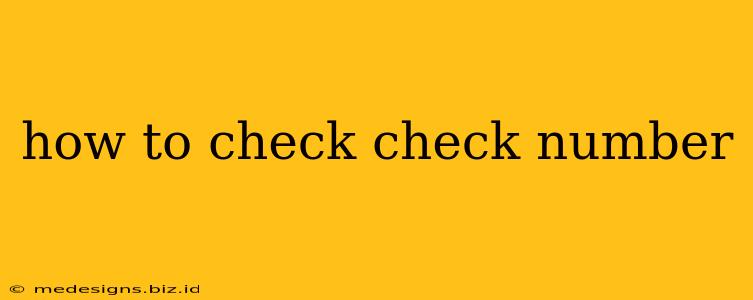Checking the number on a check might seem straightforward, but there are several reasons why you might need to verify it and different ways to do so depending on your needs. This guide covers various methods to help you check a check number accurately and efficiently.
Why Check Your Check Number?
Before diving into the how, let's understand the why. Knowing your check number is crucial for several reasons:
- Reconciling your bank account: Matching check numbers on your bank statement with your own records is essential for accurate accounting and identifying potential discrepancies.
- Tracking payments: If you've written a check and need to follow up on its status, the check number serves as a unique identifier.
- Identifying fraudulent activity: If you suspect unauthorized use of your checking account, comparing check numbers can help pinpoint suspicious transactions.
- Resolving discrepancies: If there's a difference between your records and your bank statement, the check number is key to investigation.
Methods to Check Your Check Number
There are several ways to find the check number, depending on whether you have the physical check or need to access information digitally:
1. Locating the Check Number on a Physical Check
The most straightforward method is to examine the check itself. The check number is usually located in one of these places:
- Top right corner: This is the most common location.
- Bottom left corner: Some check formats place it here.
- Near the MICR line: The Magnetic Ink Character Recognition (MICR) line at the bottom contains banking information, including the check number in machine-readable form, but it's difficult to read without specialized equipment.
How to read the check number: The check number is typically a series of digits. It's usually clearly printed and easy to identify.
2. Checking Your Check Register or Checkbook
If you keep a physical check register (or use a checkbook), this record will list the check number along with the date, payee, and amount. This is a convenient way to quickly find the information without handling the physical check itself.
3. Reviewing Your Bank Statements
Your bank statements, either in paper form or online, will list all the checks you've written along with their corresponding numbers. This method is particularly useful for reconciling your account or tracking payments over a period. Usually, it lists the check number, date, and amount, making it easier to find the right transaction.
4. Using Online Banking
Most banks offer online banking platforms. Through these platforms, you can access your transaction history, which includes details of your checks. This offers a convenient and easily searchable digital record of all your checks written.
5. Contacting Your Bank
If you can't locate the check number using the other methods, contacting your bank's customer service is the best option. They have access to your complete banking records and can help you find the specific check number you need.
Tips for Accurate Check Number Management
- Keep a detailed check register: Maintain an accurate record of all checks written to avoid confusion.
- Reconcile your account regularly: Regularly compare your check register to your bank statement to catch errors early.
- Store checks securely: Keep physical checks in a safe place to prevent loss or theft.
- Use online banking: Online banking offers convenient access to your check history and transaction details.
By following these methods and tips, you can easily check a check number whenever you need to. Remember that accurate check number management is crucial for efficient financial record-keeping and fraud prevention.
